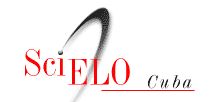Deleciones GJB6-D13S1830 y GJB6-D13S1854 en pacientes con sordera prelingual no sindrómica
Resumen
Objetivo: describir la presencia de las deleciones GJB6-D13S1830 y GJB6-D13S1854 en pacientes con sorderas no sindrómicas autosómicas recesivas.
Método: se realizó un estudio descriptivo de corte transversal, a partir 433 pacientes registrados con sorderas no sindrómicas autosómicas recesivas en el Centro Nacional de Genética Médica, en los que se había descartado previamente la presencia de la variante patogénica c.35delG del gen GJB2 en homocigosis. Fue aplicada la técnica de reacción en cadena de la polimerasa multiplex, por el que se describió el genotipo y se determinó su frecuencia.
Resultados: en 13 individuos fueron identificadas deleciones del gen GJB6, 12 en heterocigosis -en siete de ellos la GJB6-D13S1830 y en cinco la GJB6-D13S1854- y uno con la deleción GJB6-D13S1830 en homocigosis. La variante patogénica c.35delG del gen GJB2 había sido previamente identificada en heterocigosis en tres de los pacientes en quienes se identificó la GJB6-D13S1830 y dos en los que se observó la GJB6-D13S1854.
Conclusión: las deleciones GJB6-D13S1830 y GJB6-D13S1854 aparecieron en una baja proporción de los pacientes, con sorderas no sindrómicas autosómicas recesivas, estudiados y fundamentalmente se identificaron en heterocigosis.
Palabras clave
Referencias
Adam MP, Fieldman J, Mirzaa MG, Pagon RA, Wallace SE, Bean L, et al. Genetic Hearing Loss Overview. GeneReview[Internet]. Seattle:University of Washington:1993-2023[citado 28/1/2024]. Disponible en: https://www.ncbi.nlm.nih.gov/books/NBK1434/.
Walls D, Azaiez H, Smith R. Hereditary Hearing Loss Homepage[Internet]. Iowa:University of Iowa;2024[citado 7/3/2024]. Disponible en: https://hereditaryhearingloss.org.
De Rosa MA, Bernardi MT, Kleppe S, Walz K. Hearing Loss: Genetic Testing, Current Advances and the Situation in Latin America. Genes (Basel). 2024;15(2):178.
Hajilari M, Sharifinya A, Khosravi T, Kianmehr A, Taziki MH, Khosravi A, et al. Frequency of c.35delG Mutation in GJB2 gene in Patients with Autosomal Recessive Non-Syndromic Hearing Loss of Five Ethnic Groups in Golestan, Iran. Int J Pediatr. 2023;11(1):17286-98.
Del Castillo FJ, Rodríguez M, Álvarez A, Hutchin T, Leonardi E, de Oliveira CA, et al. A novel deletion involving the connexin-30 gene, del (GJB6-d13s1854), found in trans with mutations in the GJB2 gene (connexin-26) in subjects with DFNB1 non-syndromic hearing impairment. J Med Genet. 2005;42(7):588-94.
Online Mendelian Inheritance in Man. Gap junction protein, beta-6, GJB6 *604418[Internet]. Baltimore:Johns Hopkins University;2022[citado 6/3/2024]. Disponible en: https://omim.org/entry/604418.
Online Mendelian Inheritance in Man. Gap junction protein, beta-2, GJB2 *121011 Internet]. Baltimore :Johns Hopkins University;2023[citado 6/3/2024]. Disponible en: https://omim.org/entry/121011.
Del Castillo I, Moreno MA, Del Castillo FJ, Brownstein Z, Marlin S, Adina Q, et al. Prevalence and evolutionary origins of the del (GJB6-D13S1830) mutation in the DFNB1 locus in hearing-impaired subjects: a multicenter study. Am J Hum Genet. 2003;73(6):1452-8.
Morales E, Arceo M, Perdomo Y, Gómez M, Collazo T. Pathogenic variant c.35delG of the GJB2 gene associated with nonsyndromic prelingual deafness. Salud, Cien Tecnol[Internet]. 2024[citado 11/6/2024];4(2):[aprox. 10p]. Disponible en: https://revista.saludcyt.ar/ojs/index.php/sct/article/view/766.
Miller SA, Dykes DD, Polesky HF. A simple salting out procedure for extracting DNA from human nucleated cells. Nucleic Acids Res. 1988;16(3):1215.
Asociación Médica Mundial. Declaración de Helsinki de la AMM. Principios éticos para las investigaciones médicas en seres humanos. Adoptada por la 64a Asamblea General, Fortaleza, Brasil[Internet]. Brasil:AMM;2013[citado 12/5/2024]. Disponible en: https://www.wma.net/es/policies-post/declaracion-de-helsinki-de-la-amm-principios-eticos-para-las-investigaciones-medicas-en-seres-humanos/.
Kremer H, Del Castillo I. Genetics of Hearing Impairment. Genes (Basel). 2022;13(5):852
Pandya A, O’Brien A, Kovasala M, Bademci G, Tekin M, Arnos KS. Analyses of del (GJB6-D13S1830) and del (GJB6-D13S1834) deletions in a large cohort with hearing loss: Caveats to interpretation of molecular test results in multiplex families. Mol Genet Genomic Med. 2020;8(4):e1171.
Naddafnia H, Noormohammadi Z, Irani S, Salahshoorifar I. Frequency of GJB2 mutations, GJB6-D13S1830 and GJB6-D13S1854 deletions among patients with non-syndromic hearing loss from the central region of Iran. Mol Genet Genomic Med. 2019;7(7):e00780.
Enlaces refback
- No hay ningún enlace refback.
FINLAY EN: 








FINLAY CERTIFICADA POR:

Esta revista "no aplica" cargos por publicación en ninguna etapa del proceso editorial.
Dirección postal: Calle 51A y Avenida 5 de Septiembre Cienfuegos, Cuba Código postal: 55100.
http://www.revfinlay.sld.cu
Telefono: +53 43 516602. Telefax: +53 43 517733.
amgiraldoni@infomed.sld.cu
ISSN: 2221-2434
RNPS: 5129






